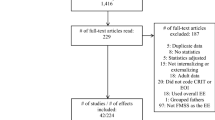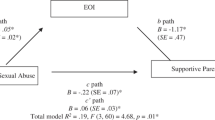Abstract
Research has documented that maternal expressed emotion-criticism (EE-Crit) from the Five-Minute Speech Sample (FMSS) predicts family conflict and children’s externalizing behavior in clinical and community samples. However, studies have not examined EE-Crit in maltreating or separated/divorced families, or whether these family risks exacerbate the links between EE-Crit and family conflict and externalizing behavior. The current study examined the associations between maternal EE-Crit, maltreatment, and separation/divorce, and whether maltreatment and separation/divorce moderated associations between EE-Crit and children’s externalizing problems, and EE-Crit and family conflict. Participants included 123 children (M = 8.01 years, SD = 1.58; 64.2 % males) from maltreating (n = 83) or low-income, comparison (n = 40) families, and 123 mothers (n = 48 separated/divorced). Mothers completed the FMSS for EE-Crit and the Family Environment Scale for family conflict. Maltreatment was coded with the Maltreatment Classification System using information from official Child Protection Services (CPS) reports from the Department of Human Services (DHS). Trained summer camp counselors rated children’s externalizing behavior. Maltreatment was directly associated with higher externalizing problems, and separation/divorce, but not maltreatment, moderated the association between EE-Crit and externalizing behavior. Analyses pertaining to family conflict were not significant. Findings indicate that maltreatment is a direct risk factor for children’s externalizing behavior and separation/divorce is a vulnerability factor for externalizing behavior in family contexts with high maternal EE-Crit. Intervention, prevention, and policy efforts to promote resilience in high-risk families may be effective in targeting maltreating and critical parents, especially those with co-occurring separation/divorce. Key Words: expressed emotion, EE-Crit, Five-Minute Speech Sample; maltreatment, divorce, externalizing behavior

Similar content being viewed by others
References
Achenbach, T., & Edelbrock, C. (1986). Manual for the teacher’s report form and the teacher version of the child behavior profile. Burlington: University of Vermont Department of Psychiatry.
Amato, P. R., & Booth, A. (2001). The legacy of parents’ marital discord: consequences for children’s marital quality. Journal of Personality and Social Psychology, 81, 627–638. doi:10.1037/0022-3514.81.4.627.
Azar, S. T. (2002). Parenting and child maltreatment. In M. H. Bornstein (Ed.), Handbook of parenting, volume 4: Social considerations and applied parenting (pp. 361–388). Mahwah: Lawrence Earlbaum Associates, Inc.
Barnett, D., Manly, J. T., & Cicchetti, D. (1993). Defining child maltreatment: The interface between policy and research. In D. Cicchetti & S. L. Toth (Eds.), Child abuse, child development and social policy (pp. 7–74). Norwood: Ablex.
Bronfenbrenner, U. (1979). The ecology of human development: Experiments by nature and design. Cambridge: Harvard University Press.
Calam, R., Bolton, C., Barrowclough, C., & Roberts, J. (2002). Maternal expressed emotion and clinician ratings of emotional maltreatment potential. Child Abuse and Neglect, 26, 1101–1106.
Cicchetti, D., & Barnett, D. (1991). Toward the development of a scientific nosology of child maltreatment. In W. Grove & D. Cicchetti (Eds.), Thinking clearly about psychology: Essays in honor of Paul E. Meehl: Vol. 2. Personality and psychopathology (pp. 346–377). Minneapolis: University of Minnesota Press.
Cicchetti, D., & Howes, P. W. (1991). Developmental psychopathology in the context of the family: illustrations from the study of child maltreatment. Canadian Journal of Behavioural Science, 23, 257–281. doi:10.1037/h0079020.
Cicchetti, D., & Lynch, M. (1993). Toward an ecological/transactional model of community violence and child maltreatment: consequences for children’s development. Psychiatry, 56, 96–118.
Cicchetti, D., & Manly, J. T. (1990). A personal perspective on conducting research with maltreating families: Problems and solutions. In G. H. Brody & I. E. Sigel (Eds.), Methods of family research: Biographies of research projects: Vol. 2. Clinical populations (pp. 87–133). Hillsdale: Erlbaum.
Cicchetti, D., & Rogosch, F. A. (1997). The role of self-organization in the promotion of resilience in maltreated children. Development and Psychopathology, 9, 797–815. doi:10.1017/S0954579497001442.
Cicchetti, D., & Valentino, K. (2006). An ecological transactional perspective on child maltreatment: Failure of the average expectable environment and its influence on child development. In D. Cicchetti & D. J. Cohen (Eds.), Developmental Psychopathology: Vol. 3: Risk, disorder, and adaptation (pp. 129–201). New York: Wiley.
Cicchetti, D., Rogosch, F. A., Lynch, M., & Holt, K. D. (1993). Resilience in maltreated children: processes leading to adaptive outcome. Development and Psychopathology, 5, 629–647. doi:10.1017/S0954579400006209.
Cook, D. R., & Weisberg, S. (1982). Residuals and influence in regression. London: Chapman & Hall.
Corse, S. J., Schmid, K., & Trickett, P. K. (1990). Social networking characteristics of mothers in abusing and non-abusing families and their relationships to parenting beliefs. Journal of Community Psychology, 18, 44–59. doi:10.1002/1520-6629(199001)18:1<44::AID-JCOP2290180107>3.0.CO;2-F.
Davis, C. A., & Graybill, D. (1983). Comparison of family environments of abused versus non-abused children. Psychology: A Quarterly Journal of Human Behavior, 20, 34–37.
Egeland, B., Breitenbuchcr, M., & Rosenberg, D. (1980). Prospective study of the significance of life stress in the etiology of child abuse. Journal of Consulting and Clinical Psychology, 48, 195–205. doi:10.1037/0022-006X.48.2.195.
Emery, R. E. (1982). Interparental conflict and the children of discord and divorce. Psychological Bulletin, 92, 310–330. doi:10.1037/0033-2909.92.2.310.
Fiese, B. H., & Spagnola, M. (2007). The interior life of the family: Looking from the inside out and the outside in. In A. Masten (Ed.), The Minnesota Symposium on Child Psychology, Vol. 34: Multilevel dynamics in developmental psychopathology: Pathways to the future (pp. 119–150). New York: Cambridge University Press.
Frye, A. A., & Garber, J. (2005). The relations among maternal depression, maternal criticism, and adolescents’ externalizing and internalizing symptoms. Journal of Abnormal Child Psychology, 33, 1–11. doi:10.1007/s10802-005-0929-9.
Garmezy, N. (1983). Stressors of childhood. In N. Garmezy & M. Rutter (Eds.), Stress, coping, and development (pp. 43–84). New York: McGraw-Hill.
Gaudin, J. M., Polansky, N. A., Kilpatrick, A. C., & Shilton, P. (1996). Family functioning in neglectful families. Child Abuse & Neglect, 20, 363–377. doi:10.1016/0145-2134(96)00005-1.
Hecht, D. B., & Hansen, D. J. (2001). The environment of child maltreatment: contextual factors and the development of psychopathology. Aggression and Violent Behavior, 6, 433–457. doi:10.1016/S1359-1789(00)00015-X.
Hetherington, E. M. (1979). Divorce: a child’s perspective. American Psychologist, 34, 851–858. doi:10.1037/0003-066X.34.10.851.
Hirshfeld, D. R., Biederman, J., Brody, L., Faraone, S. V., & Rosenbaum, J. F. (1997). Associations between expressed emotion and child behavioral inhibition and psychopathology: a pilot study. Journal of the American Academy of Child and Adolescent Psychiatry, 36, 205–213. doi:10.1097/00004583-199702000-00011.
Jenkins, J. H., & Karno, M. (1992). The meaning of expressed emotion: theoretical issues raised by cross-cultural research. American Journal of Psychiatry, 149, 9–21.
Kuipers, L. (1992). Expressed emotion research in Europe. British Journal of Clinical Psychology, 32, 429–443. doi:10.1111/j.2044-8260.1992.tb01017.x.
Lansford, J. E., Malone, P. S., Castellino, D. R., Dodge, K. A., Pettit, G. S., & Bates, J. E. (2006). Trajectories of externalizing, internalizing, and grades for children who have or have not experienced their children’s divorce or separation. Journal of Family Psychology, 20, 292–301. doi:10.1037/0893-3200.20.2.292.
Magaña-Amato, A. (1993). Manual for coding expressed emotion from the five-minute speech sample: UCLA Family Project. Los Angeles: University of California, Los Angeles.
Manly, J. T., Cicchetti, D., & Barnett, D. (1994). The impact of subtype, frequency, chronicity, and severity of child maltreatment on social competence and behavior problems. Development and Psychopathology, 6, 121–143. doi:10.1017/S0954579400005915.
Manly, J. T., Kim, J. E., Rogosch, F. A., & Cicchetti, D. (2001). Dimensions of child maltreatment and children’s adjustment: contributions of developmental timing and subtype. Development and Psychopathology, 13, 759–782.
McCarty, C. A., & Weisz, J. R. (2002). Correlates of expressed emotion in mothers of clinically referred youth: an examination of the five minute speech sample. Journal of Child Psychology and Psychiatry, 43(6), 759–768. doi:10.1111/1469-7610.00090.
McCarty, C. A., Lau, A. S., Valeri, S. M., & Weisz, J. R. (2004). Parent–child interactions in relation to critical and emotionally over involved expressed emotion (EE): is EE a proxy for behavior? Journal of Abnormal Child Psychology, 32, 83–93. doi:10.1023/B:JACP.0000007582.61879.6f.
Miklowitz, D. (2004). The role of family systems in severe and recurrent psychiatric disorders: a developmental psychopathology view. Development and Psychopathology, 16, 667–688. doi:10.1017/S0954579404004729.
Moos, R. H. (1990). Conceptual and empirical approaches to developing family-based assessment procedures: resolving the case of the family environment scale. Family Process, 299, 199–208. doi:10.1111/j.1545-5300.1990.00199.x.
Narayan, A. J., Herbers, J. E., Plowman, E. J., Gewirtz, A. H., & Masten, A. S. (2012). Expressed emotion in homeless families: a methodological study of the five-minute speech sample. Journal of Family Psychology, 26, 648. doi:10.1037/a0028968.
Narayan, A. J., Sapienza, J. K., Monn, A. R., Lingras, K. A., & Masten, A. S. (2014). Risk, vulnerability, and protective processes of parental expressed emotion for children’s peer relations in contexts of parental violence. Journal of Clinical Child and Adolescent Psychology. doi:10.1080/15374416.2014.881292.
Nelson, D. R., Hammen, C., Brennan, P. A., & Ullman, J. B. (2003). The impact of maternal depression on adolescent adjustment: the role of expressed emotion. Journal of Consulting and Clinical Psychology, 71, 935–944. doi:10.1037/0022-006X.71.5.935.
Patterson, G. R. (1982). Coercive family processes. Eugene: Castalia.
Peris, T. S., & Hinshaw, S. P. (2003). Family dynamics and preadolescent girls with ADHD: the relationship between expressed emotion, ADHD symptomatology, and comorbid disruptive behavior. Journal of Child Psychology and Psychiatry, 44, 1177–1190. doi:10.1111/1469-7610.00199.
Rawlings, J. O. (1988). Applied regression analysis: A research tool. Pacific Grove: Wadsworth & Brooks/Cole Advanced Books and Software.
Rogosch, F. A., Cicchetti, D., & Toth, S. L. (2004). Expressed emotion in multiple subsystems of the families with toddlers of depressed mothers. Development and Psychopathology, 16, 689–709. doi:10.1017/S0954579404004730.
Rutter, M. L. (1999). Psychosocial adversity and child psychopathology. The British Journal of Psychiatry, 174, 480–493. doi:10.1192/bjp.174.6.480.
Sameroff, A. J., & Seifer, R. (1983). Familial risk and child competence. Child Development, 54, 1254–1268. doi:10.2307/1129680.
Sameroff, A., Gutman, L. M., & Peck, S. C. (2003). Adaptation among youth facing multiple risks: Prospective research findings. In S. Luthar (Ed.), Resilience and vulnerability: Adaptation in the context of childhood adversities (pp. 346–391). New York: Cambridge University Press.
Sher-Censor, E., Grey, I., & Yates, T. M. (2013). The intergenerational congruence of mothers’ and preschoolers’ narrative affective content and narrative coherence. International Journal of Behavioral Development, 37, 340–348. doi:10.1177/0165025413482760.
Simoneau, T. L., Miklowitz, D. J., & Saleem, R. (1998). Expressed emotion and interactional patterns in the families of bipolar patients. Journal of Abnormal Psychology, 107, 497–507. doi:10.1037/0021-843X.107.3.497.
Simons, R. L., Lin, K.-H., Gordon, L. C., Conger, R. D., & Lorenz, F. O. (1999). Explaining the higher incidence of adjustment problems among children of divorce compared with those in two-parent families. Journal of Marriage and the Family, 61, 1020–1033. doi:10.2307/354021.
Vaughn, C. E. (1989). Expressed emotion in family relationships. Journal of Child Psychology and Psychiatry, and Allied Disciplines, 30, 13–22. doi:10.1111/j.1469-7610.1989.tb00767.x.
Vostanis, P., & Nicholls, J. (1995). The Family Environment Scale: comparison with the construct of expressed emotion. Journal of Family Therapy, 17, 299–315. doi:10.1111/j.1467-6427.1995.tb00020.x.
Webster-Stratton, C. (1990). Stress: a potential disruptor of parent perceptions and family interactions. Journal of Clinical Child Psychology, 19, 302–312. doi:10.1207/s15374424jccp1904_2.
Acknowledgments
Preparation of this manuscript was supported in part by grants from the Spunk Fund, Inc., and a predoctoral traineeship from the National Institute of Mental Health (5 T-32 MH015755) and a Graduate School Fellowship from the University of Minnesota to the first author.
Conflict of Interest
The authors declare that they have no conflict of interest.
Author information
Authors and Affiliations
Corresponding author
Rights and permissions
About this article
Cite this article
Narayan, A., Cicchetti, D., Rogosch, F.A. et al. Interrelations of Maternal Expressed Emotion, Maltreatment, and Separation/Divorce and Links to Family Conflict and Children’s Externalizing Behavior. J Abnorm Child Psychol 43, 217–228 (2015). https://doi.org/10.1007/s10802-014-9911-8
Published:
Issue Date:
DOI: https://doi.org/10.1007/s10802-014-9911-8




